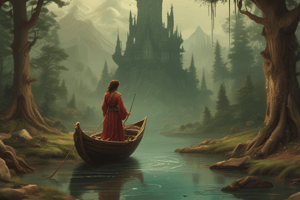Podcast
Questions and Answers
What is the primary purpose of creative writing?
What is the primary purpose of creative writing?
To express the writer's ideas and emotions in an artistic manner.
Name two types of creative works.
Name two types of creative works.
Poetry and fiction.
What does auditory imagery refer to?
What does auditory imagery refer to?
Descriptions of sounds that we can hear.
Explain the term diction in literature.
Explain the term diction in literature.
What type of diction is characterized by the use of formal words in formal situations?
What type of diction is characterized by the use of formal words in formal situations?
Define simile.
Define simile.
What do figures of speech achieve in writing?
What do figures of speech achieve in writing?
What does tactile imagery describe?
What does tactile imagery describe?
Flashcards are hidden until you start studying
Study Notes
Creative Writing Overview
- Artistic expression through written word, aiming to convey ideas and emotions.
- Engages and entertains the audience, differing from more conventional writing forms.
- Creative works are categorized into poetry, fiction, and drama.
Imagery
- Language technique that evokes sensory experiences.
- Creates mental pictures for readers, enhancing their connection to the text.
- Types of imagery include:
- Visual imagery: Encompasses color, shapes, sizes, and patterns.
- Auditory imagery: Focuses on sounds, ranging from music to silence.
- Olfactory imagery: Relates to smells, including fragrances and odors.
- Gustatory imagery: Involves tastes, from sweetness to saltiness.
- Tactile imagery: Pertains to physical sensations like texture and temperature.
Diction
- Refers to word choice in writing, pivotal for literary expression.
- Influences action portrayal, character development, thematic identification, and value suggestions.
- Key components of diction include language formality, emotional weight, imagery, specificity, and auditory quality.
Types of Diction
- Formal diction: Utilizes elevated language for serious contexts.
- Informal diction: Uses casual language suitable for conversational settings.
- Colloquial diction: Incorporates regional vernacular and common speech.
- Slang diction: Features modern, often informal terms, sometimes with impolite connotations.
Figures of Speech
- Non-literal expressions enhancing rhetorical and vivid effect in writing.
- Common figures of speech include:
- Simile: Direct comparison using "like" or "as" to relate different entities.
- Metaphor: Implicit comparison between unlike objects sharing common traits.
- Onomatopoeia: Words that mimic the sounds of the actions or objects they refer to.
- Personification: Assigns human qualities to non-human entities or abstractions.
Studying That Suits You
Use AI to generate personalized quizzes and flashcards to suit your learning preferences.




